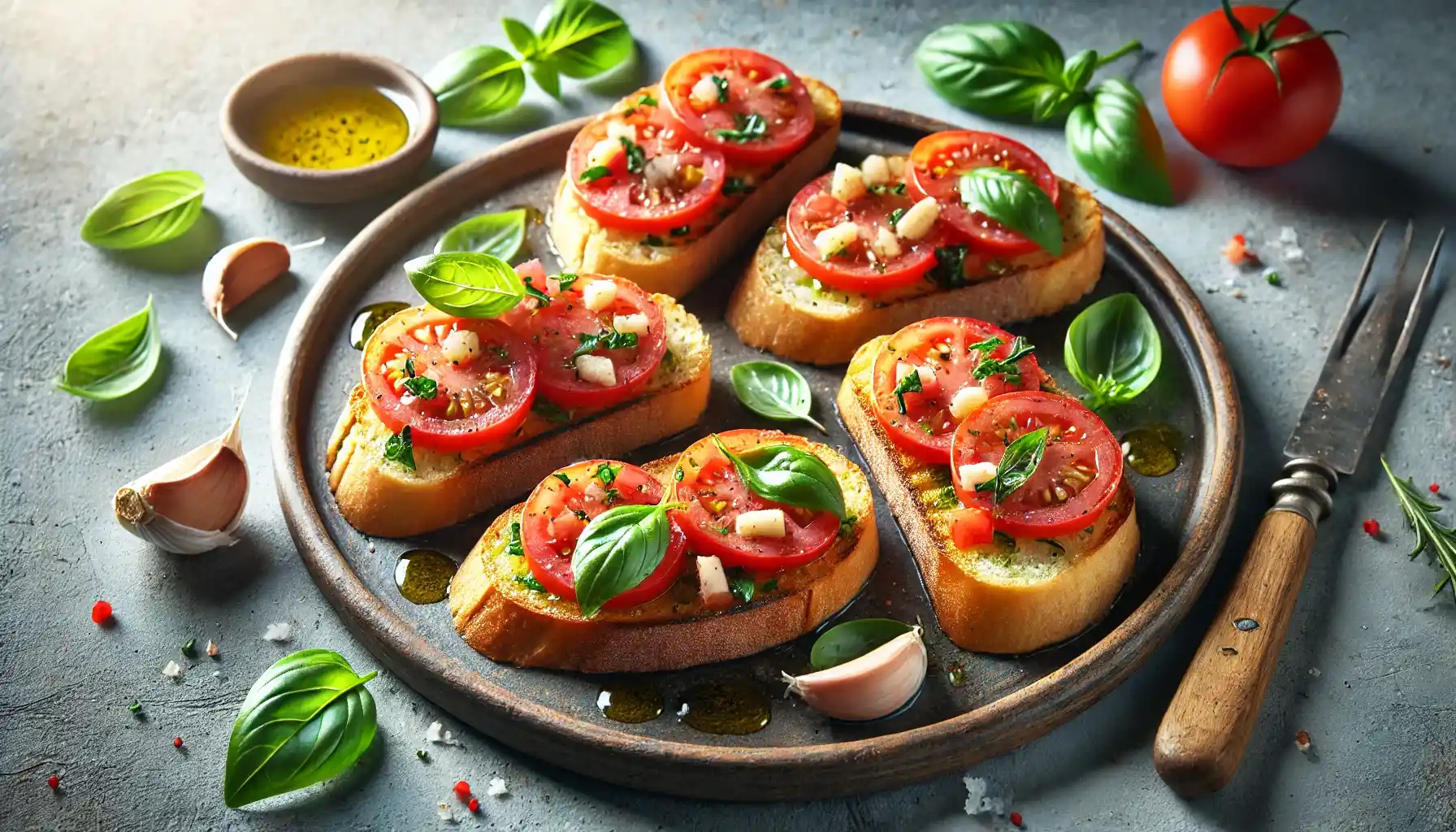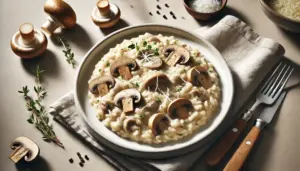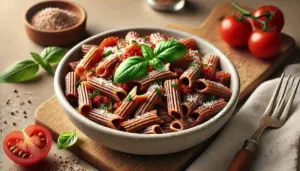Bruschetta, pronounced “broo-sketta,” is an Italian appetizer that has become a staple on menus worldwide. This simple yet elegant dish features toasted bread topped with fresh ingredients, making it a delightful start to any meal. Originating from Italy, bruschetta showcases the Mediterranean emphasis on fresh, high-quality ingredients and simple preparation methods. This article delves into the history of bruschetta, its nutritional profile, traditional and modern variations, and a step-by-step recipe for creating the perfect bruschetta at home.
A Brief History of Bruschetta
Bruschetta dates back centuries, with roots in ancient Rome. The word “bruschetta” comes from the Italian verb bruscare, which means “to roast over coals.” Originally, bruschetta was a way for farmers to enjoy leftover or stale bread by toasting it and rubbing it with garlic, then drizzling it with olive oil and sprinkling salt. It was a simple snack, but one that celebrated the flavors of fresh, rustic Italian ingredients.
Over time, bruschetta evolved from being a rustic farmer’s food to a popular appetizer in Italian cuisine. Today, it is commonly topped with diced tomatoes, basil, and mozzarella, although countless variations exist. Bruschetta is still cherished for its versatility, simplicity, and the way it enhances the flavors of fresh, high-quality ingredients.
Nutritional Profile of Bruschetta
Bruschetta is generally a light and nutritious appetizer, especially when made with traditional ingredients like whole-grain bread, tomatoes, garlic, and olive oil. Here’s a typical nutritional breakdown per serving (about two pieces):
- Calories: 170 kcal
- Carbohydrates: 20g
- Protein: 4g
- Fat: 8g
- Fiber: 2g
- Vitamin C: 12 mg
- Vitamin A: 350 IU
- Potassium: 210 mg
- Sodium: 200 mg (varies with salt usage)
Health Benefits:
- Heart-Healthy Fats: Olive oil, the primary fat in bruschetta, contains monounsaturated fats and antioxidants that are beneficial for heart health.
- Low-Calorie: Bruschetta is relatively low in calories, making it a great choice for those watching their caloric intake.
- Rich in Antioxidants: Tomatoes contain lycopene, an antioxidant linked to reduced risks of certain cancers and cardiovascular diseases.
- Fiber and Nutrients: Whole-grain bread provides fiber, while tomatoes and garlic offer essential vitamins and minerals.
Traditional Bruschetta Recipe
The classic Italian bruschetta is simple, highlighting fresh, quality ingredients. Here’s a step-by-step recipe to make traditional tomato basil bruschetta at home.
Ingredients:
- Fresh Italian or French baguette: 1 loaf (cut into 1/2-inch slices)
- Tomatoes: 2 large, diced (preferably Roma or cherry tomatoes for sweetness)
- Fresh basil leaves: 8-10, chopped
- Garlic cloves: 1-2, peeled and halved
- Extra virgin olive oil: 2-3 tablespoons
- Balsamic vinegar: 1 teaspoon (optional, for a slight tang)
- Salt and black pepper: to taste
Preparation Steps:
- Prepare the Bread: Preheat the oven to 400°F (200°C). Arrange the sliced bread on a baking sheet. Toast in the oven for 5-6 minutes, or until the bread is golden brown and crisp.
- Rub with Garlic: While the bread is warm, rub each slice with the cut side of a garlic clove. This step infuses the bread with a subtle garlic flavor without overpowering the other ingredients.
- Prepare the Tomato Topping: In a medium bowl, combine the diced tomatoes, chopped basil, a tablespoon of olive oil, and balsamic vinegar (if using). Season with salt and pepper to taste.
- Assemble the Bruschetta: Spoon the tomato mixture onto each toasted slice of bread. Drizzle a little extra virgin olive oil over the top.
- Serve: Arrange the bruschetta on a platter and serve immediately for the best texture and flavor.
Tips for Making the Perfect Bruschetta
- Use Fresh Ingredients: Bruschetta relies on the quality of each ingredient, so opt for ripe, juicy tomatoes, fresh basil, and good-quality olive oil.
- Choose the Right Bread: Italian or French baguettes work best because they are sturdy and toast well without getting soggy.
- Add Balsamic Vinegar Sparingly: A drizzle of balsamic vinegar can enhance the flavors, but too much can overpower the other ingredients.
- Serve Immediately: Bruschetta is best enjoyed fresh. Once assembled, the bread can become soggy if left for too long, so serve it as soon as possible after adding the toppings.
Variations of Bruschetta
One of the reasons bruschetta is so beloved is its versatility. Here are some popular variations that go beyond the classic tomato-basil combination:
- Caprese Bruschetta: Add fresh mozzarella slices to the classic tomato and basil topping for a Caprese-inspired bruschetta. Drizzle with balsamic glaze for a sweet and tangy finish.
- Bruschetta with Avocado: For a twist, add diced avocado to the tomato mixture. The creaminess of avocado complements the acidity of tomatoes, making it a delicious variation.
- Mushroom Bruschetta: Sauté mushrooms with garlic and herbs, then spoon them onto the toasted bread. This earthy version is perfect for mushroom lovers.
- Roasted Pepper and Goat Cheese Bruschetta: Roast red bell peppers and mix with creamy goat cheese. This combination adds a sweet and tangy flavor with a rich, creamy texture.
- Bruschetta with Ricotta and Honey: For a sweet version, spread ricotta cheese on the toasted bread, drizzle with honey, and add a few crushed walnuts. This variation makes a delightful breakfast or dessert bruschetta.
- Fig and Prosciutto Bruschetta: Top the bread with sliced figs, thin prosciutto, and a drizzle of honey. This savory-sweet combination is ideal for a sophisticated appetizer.
Creative Toppings and Additions for Bruschetta
Bruschetta toppings are only limited by your imagination. Here are some unique ideas to inspire your next bruschetta creation:
- Smoked Salmon and Cream Cheese: Spread cream cheese on toasted bread, then top with smoked salmon and capers for a luxurious twist.
- Hummus and Grilled Vegetables: Spread hummus on each slice and top with grilled zucchini, bell peppers, or eggplant for a Mediterranean flavor.
- Apple and Brie: Add thinly sliced apples and a piece of Brie cheese, then broil for a few seconds until the cheese melts. A drizzle of honey adds the perfect sweetness.
- Herbed Goat Cheese and Roasted Grapes: Spread herbed goat cheese on each toast and top with roasted grapes. This combination of sweet and savory flavors is both unique and delicious.
Fun Facts About Bruschetta
- Ancient Origins: Bruschetta was originally a way to salvage stale bread, making it a sustainable and zero-waste food long before these ideas became popular.
- Popular Italian Starter: In Italy, bruschetta is often served as an appetizer (antipasto) in traditional restaurants, especially in regions like Tuscany and Lazio.
- Celebrated Worldwide: While bruschetta is Italian, it has become a favorite across many cultures, leading to countless regional variations and interpretations.
- A Symbol of Italian Simplicity: Bruschetta embodies the Italian culinary philosophy of using fresh, simple ingredients to create flavorful dishes.
Healthier Alternatives and Modifications
Bruschetta is relatively healthy, but here are some tips for making it even more nutritious:
- Use Whole-Grain Bread: Opt for whole-grain or sourdough bread instead of white bread to increase fiber and nutrient content.
- Add Protein: Top your bruschetta with sources of protein like beans, chickpeas, or thin slices of grilled chicken for a more filling snack.
- Go Light on the Oil: Use a brush to apply olive oil to the bread slices instead of pouring, which helps reduce the amount used.
- Experiment with Vegetables: Add more veggies to your toppings, like diced bell peppers, spinach, or arugula, for extra vitamins and minerals.
Serving Suggestions for Bruschetta
Bruschetta is best served as an appetizer or snack, but it can also be part of a larger meal. Here are a few ways to enjoy it:
- As an Appetizer Platter: Serve a variety of bruschetta flavors on a large platter for a beautiful and colorful appetizer spread.
- With Soup or Salad: Bruschetta pairs wonderfully with soups and salads, especially tomato basil soup or a fresh arugula salad.
- For Brunch: Offer bruschetta with different toppings as part of a brunch spread alongside scrambled eggs, fruit, and coffee.
- Accompanied by Wine: Serve bruschetta with Italian wines like Chianti, Pinot Grigio, or Prosecco. The flavors of fresh tomatoes and basil complement the acidity in these wines.
Conclusion
Bruschetta is much more than a piece of bread with toppings—it’s a celebration of fresh, high-quality ingredients and simple, authentic Italian flavors.
From the traditional tomato and basil topping to creative variations with ingredients like avocado, mushrooms, or prosciutto, bruschetta can be tailored to suit any taste preference. Its nutritional benefits, ease of preparation, and versatility make it a timeless favorite.
Whether you’re hosting a dinner party or looking for a quick and delicious snack, bruschetta offers a sophisticated yet simple option that’s sure to impress. So, gather your ingredients, toast some bread, and enjoy the beauty of bruschetta in all its delicious forms.




